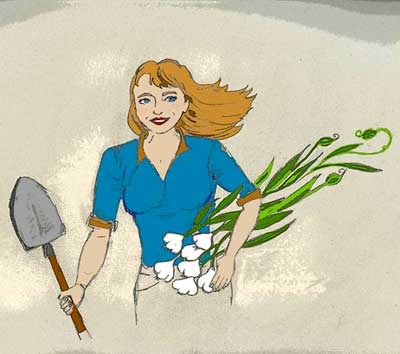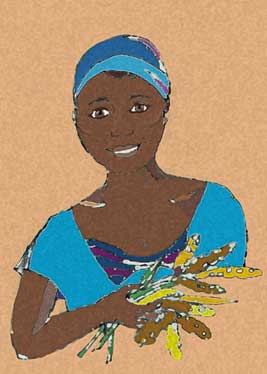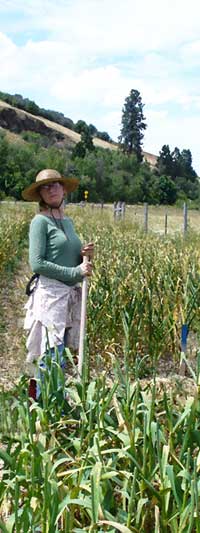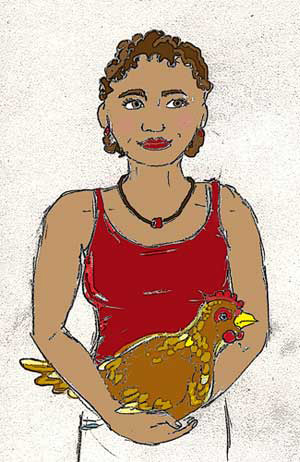Grey Duck Garlic
Women and Farming: Tips for Women Growers
Farming Facts
Making Farming Work for Women: Tool Tips!

Farming Facts (from USDA 2011 and 2012 survey and the Organic Farming Research Foundation):
Women farmers and ranchers control 7% of US farmland and account for 3% of sales. Women are more likely to be the primary operator of a small farm. The average size of women's farms is 40 acre and 91% of female run farms had less than $50,000 in income.
Women are involved in 30% of all farms in the USA either as primary, secondary or tercery operators. This number has tripled in the last 30 years.
In the USA, women are the primary operator of 14% of all farms and 22% of all organic farms. The number of women run farm operations has increased from 100,000 in 1978 to 250,000 in 2011.
Texas has the most women farmers but Arizona has the highest percentage of women farmers at 45%!
Women managing organic farms are more likely than men to devote farm space to herbs and vegetables. On the average, women earmark 47% of space to grow vegetables while men allocate only 33%.
Women Farmers Worldwide
Worldwide, there are 564 million women in agriculture. Women make up 43% of the agricultural workforce in developing nations. In these nations, women are capable farmers but produce 10-30%  less yield due to less ability to obtain credit or loans for fertilizer or expansion, less access to owning farmland and large livestock, less extension support, and a large gender educational gap (O'Sullivan et al. 2014).
less yield due to less ability to obtain credit or loans for fertilizer or expansion, less access to owning farmland and large livestock, less extension support, and a large gender educational gap (O'Sullivan et al. 2014).
For a full report of the plight of African women farmers see Leveling the Field: Improving Opportunities for Women Farmers in Africa.
How Important is This?
If women farmers had access to the tools they need to farm, the Food and Agricultural Organization of the United Nations (FOA) estimates that 100-150 MILLION more people could be fed!
How Can You Help Women in Agriculture?
Organizations are trying to address the educational and legal challenges for women farmers.
Consider organizations such as these that offer a hand up not a handout:
Landesa fighting for fair land rights. Many poor people around the world have no legal control over the land they farm.
Resources for US women and minorities:
The USDA targets underserved farmers for a portion of all Guaranteed loan funds, Direct Operating and Direct Farm Ownership loan funds, Microloan funding, and Youth loans.
Underserved farmers and ranchers include women, African-Americans, Alaskan Natives, American Indians, Hispanic, Asian, Native Hawaiians and Pacific Islanders.
Making Farming Work for You
Farming doesn't have to be hard work. Since most women don't have the sheer upper body strength of men we need to work smarter not harder.
Consider Tool Size
Most tools are made for men not women. Handles are too long, shovel heads are too big, handle ends are for larger hands, wheelbarrows hold too much, and the entire tool weighs too much. In order to use a tool effortlessly all day long you need a tool sized for you, not a big hulking guy who Mother Nature invested with more upper body strength.
At Grey Duck Garlic we invested in smaller shovels, 4 cubic foot wheelbarrows, and smaller hoes and rakes. The guys call them women tools and we women love them (in all fairness we keep a few guy tools around for when the men help us)!
I can use a smaller wheelbarrow for hours without getting winded like I would with one that holds 150% more volume (and seemingly 2 ton heavier). It may not seem like much but the extra 2 cubic feet make a big difference when you are moving manure or soil by hand. 
Picture: Patty holds a women sized shovel. Avoid large sized tools which are harder to handle. Some tools can weigh 4-5 times more than others. You want a sturdy tool but not something that requires a forklift to raise it.
Likewise, proper sized tools help prevent injury. When you use the wrong sized tool you throw your body out of alignment, develop more blisters and are more likely to hurt yourself. 'Man-handling' (or should we say 'women-handling') a 25 pound shovel all day can wear you out quick and tired people are more likely to get injured.
Keep Your Tools Sharp
Jane has appointed herself the Official Tool Sharpener. Usually you see this character in earthy blogs, sporting a long grey beard, wearing sunglasses, and sitting on a lawn chair pithily sharpening tools while the young'ums work.
Normally the caption underneath reads something like "Old Ned, or Grand Pappy as we call him, sharpening the okra picker". It is always pretty clear that Grand Pappy is quite the character and definitely does things his own way. Well, Jane has refused to grow the facial hair but otherwise has embodied the spirit of the Official Tool Sharpener. She even has the sunglasses, lawn chair and proper attitude.
When we are digging Jane re-sharpens our shovels every plot or so. You will not believe the incredible difference a sharp shovel or hoe makes when you are digging or weeding! As one of the Official Diggers/Weeders I can honestly say that I am not too proud to beg to convince my mom to sharpen my shovel (apparently you are never too old to beg from your mom).
Only Plant One Seed at a Time
 We want you to succeed. I know it is easy to get carried away with the gorgeous seed catalogs and beautiful vegetables available at the Farmer's Market. However, to ensure success you want to start small and learn as you go. Before you buy an acre's worth of plants to grow you need to ask yourself some tough questions.
We want you to succeed. I know it is easy to get carried away with the gorgeous seed catalogs and beautiful vegetables available at the Farmer's Market. However, to ensure success you want to start small and learn as you go. Before you buy an acre's worth of plants to grow you need to ask yourself some tough questions.
Philosophical Farming Questions to Ponder
- Is your soil prepared? Do you need special considerations like raised beds in order to work efficiently and/or pain free? People of all abilities can farm, but some may need to modify the basic tilled soil + seeds = farm equation.
- Will the crop grow in your climate or soil? Make it easy for yourself by selecting plants that like your climate. Why torture yourself with babying exotic 'fussy' plants that would sooner get root rot than socialize with you?
- Will you go out and take care of your crop even in bad weather? Some tasks can be put off until nice sunny days but other things need to be done even in the face of unexpected blizzards, weather hot enough to fry an egg on the sidewalk, or giant grasshopper attacks.
- If you are growing for market, where will you sell your crop? Do you want to sell locally, at Farmers Markets, to restaurants or on the internet? Is there a market for what you want to grow? Can you create a market for what you grow? If not can you and Grand Pappy eat it all?
- Do you even like growing plants for food? Will 500 pounds of tomatoes make you start your own Tomato Festival or drive you to start a one person Tomato Throwing Festival (also fun but less profitable)? Test the assumption out that you love growing with a small plot before trying for 40 acres.
- Do you care if your nails get broken and dirty? Even if you wear gloves most farmers will never be hand models! On the plus side, most of us can give a nice firm handshake.
Only Risk What You Can Afford
Don't lose your shirt farming and don't quit your day job. Whatever you do, don't borrow tons of money from questionable sources that advertise 'Need Cash for Tomatoes? Fast Payday Loan Here. Only 150% Interest!' Most people start out farming as a sideline until they know whether they like it and if they can support themselves on it. Even if you are a retiree with a steady income source it is smart to start slow and build up gradually. Sure, it might take you an extra year or two but it is worth it to be safe and financially secure.
Take home message: Remember it is easy to get excited thinking about harvest but there is a lot of weeding between the planting and the eating.
References:
- O'Sullivan M. Rao A, Banerjee R, Gulati K, Vinez M. Levelling the field : improving opportunities for women farmers in Africa. Vol. 1 of Levelling the field: improving opportunities for women farmers in Africa. Washington DC; World Bank Group. 2014. Full text.
